Financial Management Report: Decision Making, Ratios, and Fraud
VerifiedAdded on 2023/01/11
|17
|5310
|61
Report
AI Summary
This report provides a comprehensive overview of financial management, focusing on its crucial role in business organizations for achieving sustainable growth. It explores various decision-making approaches, techniques, and factors that contribute to effective outcomes, including formal and informal decision-making processes, brainstorming, and cost-benefit analysis. The report delves into stakeholder management, addressing conflicting objectives and the importance of maintaining good relationships with internal and external stakeholders. It also examines the value of management accounting techniques like budgetary control and standard costing. Furthermore, the report discusses techniques for fraud detection and prevention, emphasizing the importance of identifying potential fraud areas, timely audits, and communicating implemented systems to staff. The report includes a financial ratio analysis of Morrison Supermarkets PLC, providing insights into its financial position and performance. It concludes with recommendations for improving financial sustainability. This report is a valuable resource for students studying financial management, offering insights into key concepts and practical applications.

Financial Management
Paraphrase This Document
Need a fresh take? Get an instant paraphrase of this document with our AI Paraphraser
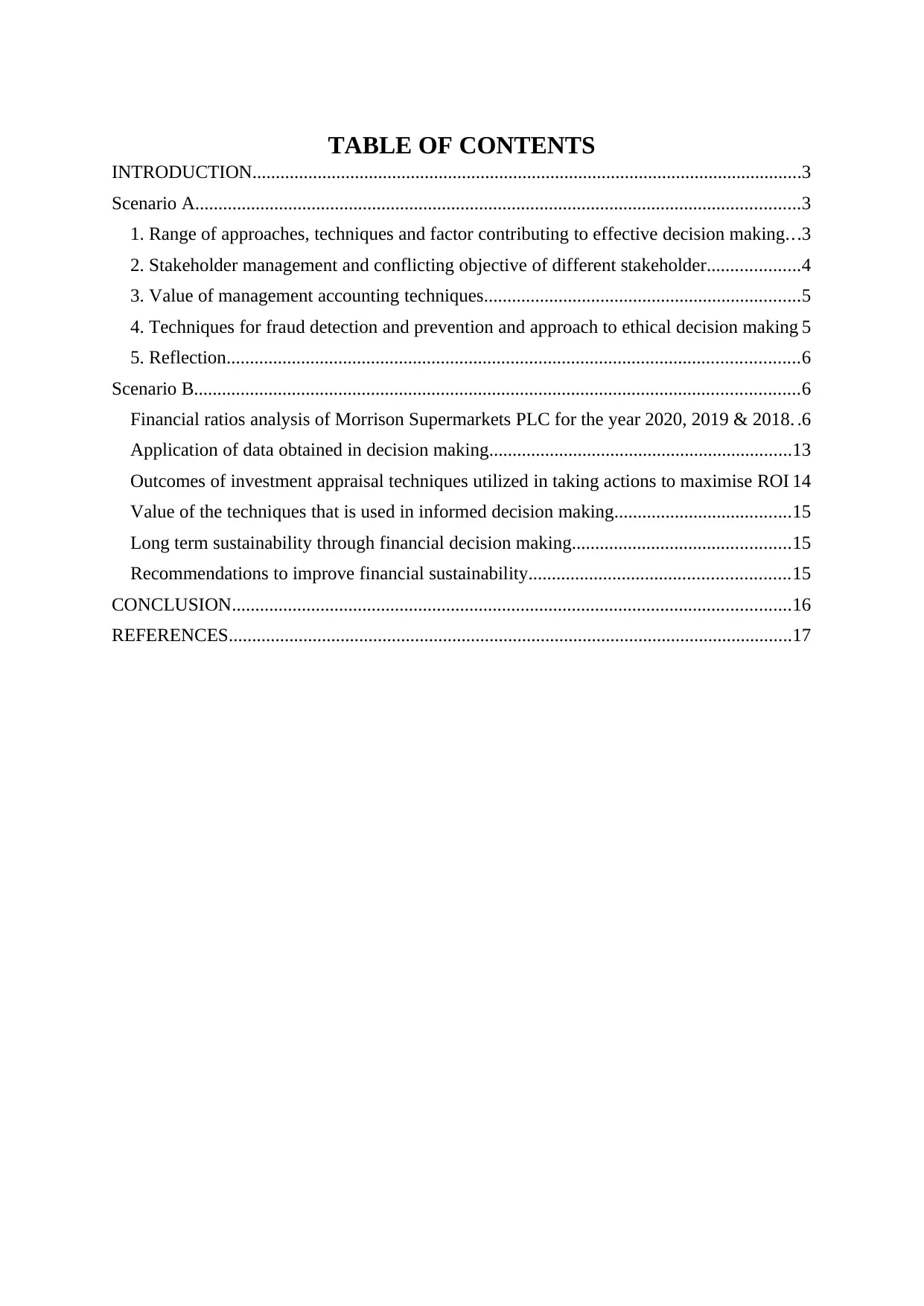
TABLE OF CONTENTS
INTRODUCTION......................................................................................................................3
Scenario A..................................................................................................................................3
1. Range of approaches, techniques and factor contributing to effective decision making...3
2. Stakeholder management and conflicting objective of different stakeholder....................4
3. Value of management accounting techniques....................................................................5
4. Techniques for fraud detection and prevention and approach to ethical decision making 5
5. Reflection...........................................................................................................................6
Scenario B..................................................................................................................................6
Financial ratios analysis of Morrison Supermarkets PLC for the year 2020, 2019 & 2018. .6
Application of data obtained in decision making.................................................................13
Outcomes of investment appraisal techniques utilized in taking actions to maximise ROI 14
Value of the techniques that is used in informed decision making......................................15
Long term sustainability through financial decision making...............................................15
Recommendations to improve financial sustainability........................................................15
CONCLUSION........................................................................................................................16
REFERENCES.........................................................................................................................17
INTRODUCTION......................................................................................................................3
Scenario A..................................................................................................................................3
1. Range of approaches, techniques and factor contributing to effective decision making...3
2. Stakeholder management and conflicting objective of different stakeholder....................4
3. Value of management accounting techniques....................................................................5
4. Techniques for fraud detection and prevention and approach to ethical decision making 5
5. Reflection...........................................................................................................................6
Scenario B..................................................................................................................................6
Financial ratios analysis of Morrison Supermarkets PLC for the year 2020, 2019 & 2018. .6
Application of data obtained in decision making.................................................................13
Outcomes of investment appraisal techniques utilized in taking actions to maximise ROI 14
Value of the techniques that is used in informed decision making......................................15
Long term sustainability through financial decision making...............................................15
Recommendations to improve financial sustainability........................................................15
CONCLUSION........................................................................................................................16
REFERENCES.........................................................................................................................17
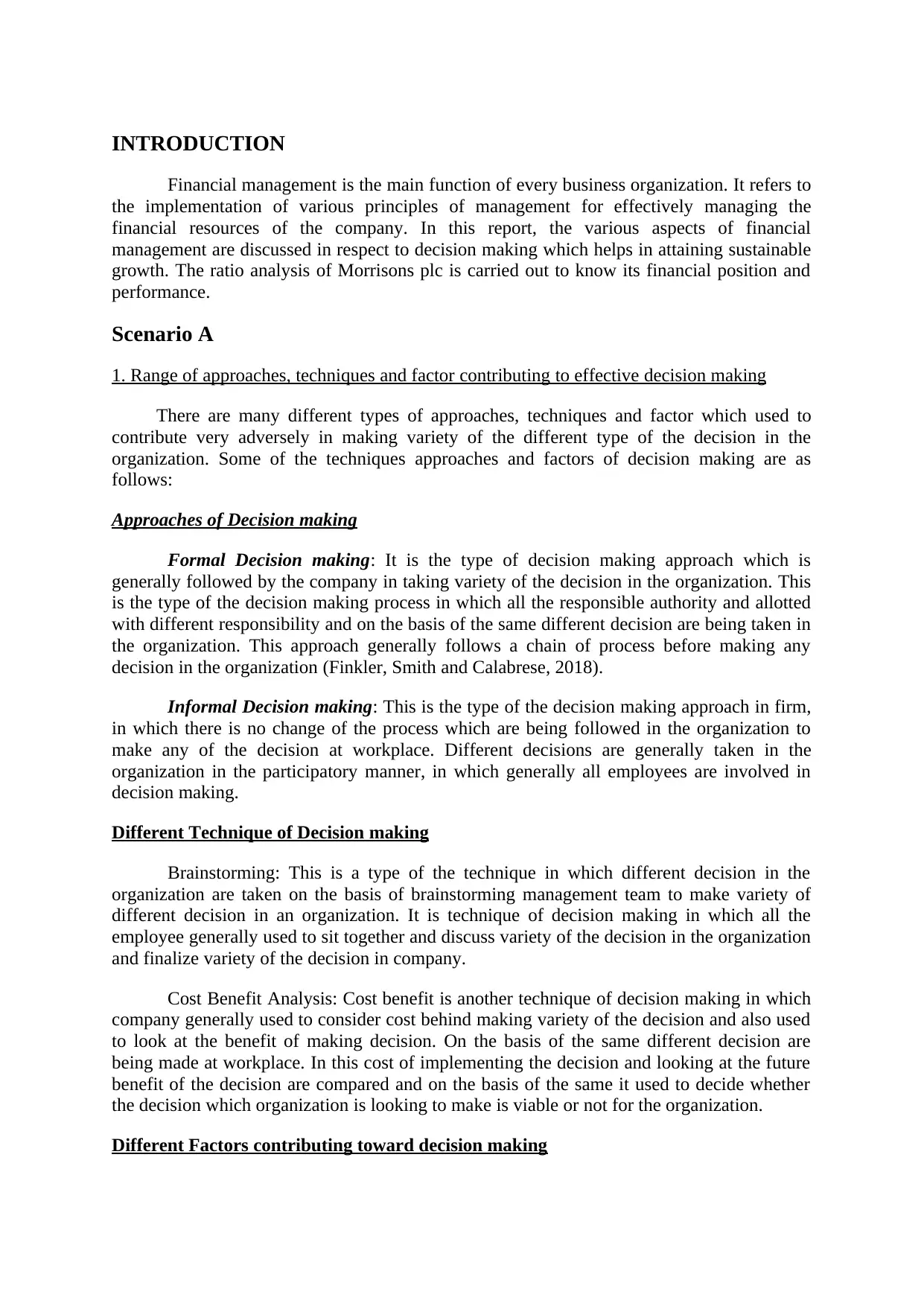
INTRODUCTION
Financial management is the main function of every business organization. It refers to
the implementation of various principles of management for effectively managing the
financial resources of the company. In this report, the various aspects of financial
management are discussed in respect to decision making which helps in attaining sustainable
growth. The ratio analysis of Morrisons plc is carried out to know its financial position and
performance.
Scenario A
1. Range of approaches, techniques and factor contributing to effective decision making
There are many different types of approaches, techniques and factor which used to
contribute very adversely in making variety of the different type of the decision in the
organization. Some of the techniques approaches and factors of decision making are as
follows:
Approaches of Decision making
Formal Decision making: It is the type of decision making approach which is
generally followed by the company in taking variety of the decision in the organization. This
is the type of the decision making process in which all the responsible authority and allotted
with different responsibility and on the basis of the same different decision are being taken in
the organization. This approach generally follows a chain of process before making any
decision in the organization (Finkler, Smith and Calabrese, 2018).
Informal Decision making: This is the type of the decision making approach in firm,
in which there is no change of the process which are being followed in the organization to
make any of the decision at workplace. Different decisions are generally taken in the
organization in the participatory manner, in which generally all employees are involved in
decision making.
Different Technique of Decision making
Brainstorming: This is a type of the technique in which different decision in the
organization are taken on the basis of brainstorming management team to make variety of
different decision in an organization. It is technique of decision making in which all the
employee generally used to sit together and discuss variety of the decision in the organization
and finalize variety of the decision in company.
Cost Benefit Analysis: Cost benefit is another technique of decision making in which
company generally used to consider cost behind making variety of the decision and also used
to look at the benefit of making decision. On the basis of the same different decision are
being made at workplace. In this cost of implementing the decision and looking at the future
benefit of the decision are compared and on the basis of the same it used to decide whether
the decision which organization is looking to make is viable or not for the organization.
Different Factors contributing toward decision making
Financial management is the main function of every business organization. It refers to
the implementation of various principles of management for effectively managing the
financial resources of the company. In this report, the various aspects of financial
management are discussed in respect to decision making which helps in attaining sustainable
growth. The ratio analysis of Morrisons plc is carried out to know its financial position and
performance.
Scenario A
1. Range of approaches, techniques and factor contributing to effective decision making
There are many different types of approaches, techniques and factor which used to
contribute very adversely in making variety of the different type of the decision in the
organization. Some of the techniques approaches and factors of decision making are as
follows:
Approaches of Decision making
Formal Decision making: It is the type of decision making approach which is
generally followed by the company in taking variety of the decision in the organization. This
is the type of the decision making process in which all the responsible authority and allotted
with different responsibility and on the basis of the same different decision are being taken in
the organization. This approach generally follows a chain of process before making any
decision in the organization (Finkler, Smith and Calabrese, 2018).
Informal Decision making: This is the type of the decision making approach in firm,
in which there is no change of the process which are being followed in the organization to
make any of the decision at workplace. Different decisions are generally taken in the
organization in the participatory manner, in which generally all employees are involved in
decision making.
Different Technique of Decision making
Brainstorming: This is a type of the technique in which different decision in the
organization are taken on the basis of brainstorming management team to make variety of
different decision in an organization. It is technique of decision making in which all the
employee generally used to sit together and discuss variety of the decision in the organization
and finalize variety of the decision in company.
Cost Benefit Analysis: Cost benefit is another technique of decision making in which
company generally used to consider cost behind making variety of the decision and also used
to look at the benefit of making decision. On the basis of the same different decision are
being made at workplace. In this cost of implementing the decision and looking at the future
benefit of the decision are compared and on the basis of the same it used to decide whether
the decision which organization is looking to make is viable or not for the organization.
Different Factors contributing toward decision making
⊘ This is a preview!⊘
Do you want full access?
Subscribe today to unlock all pages.

Trusted by 1+ million students worldwide
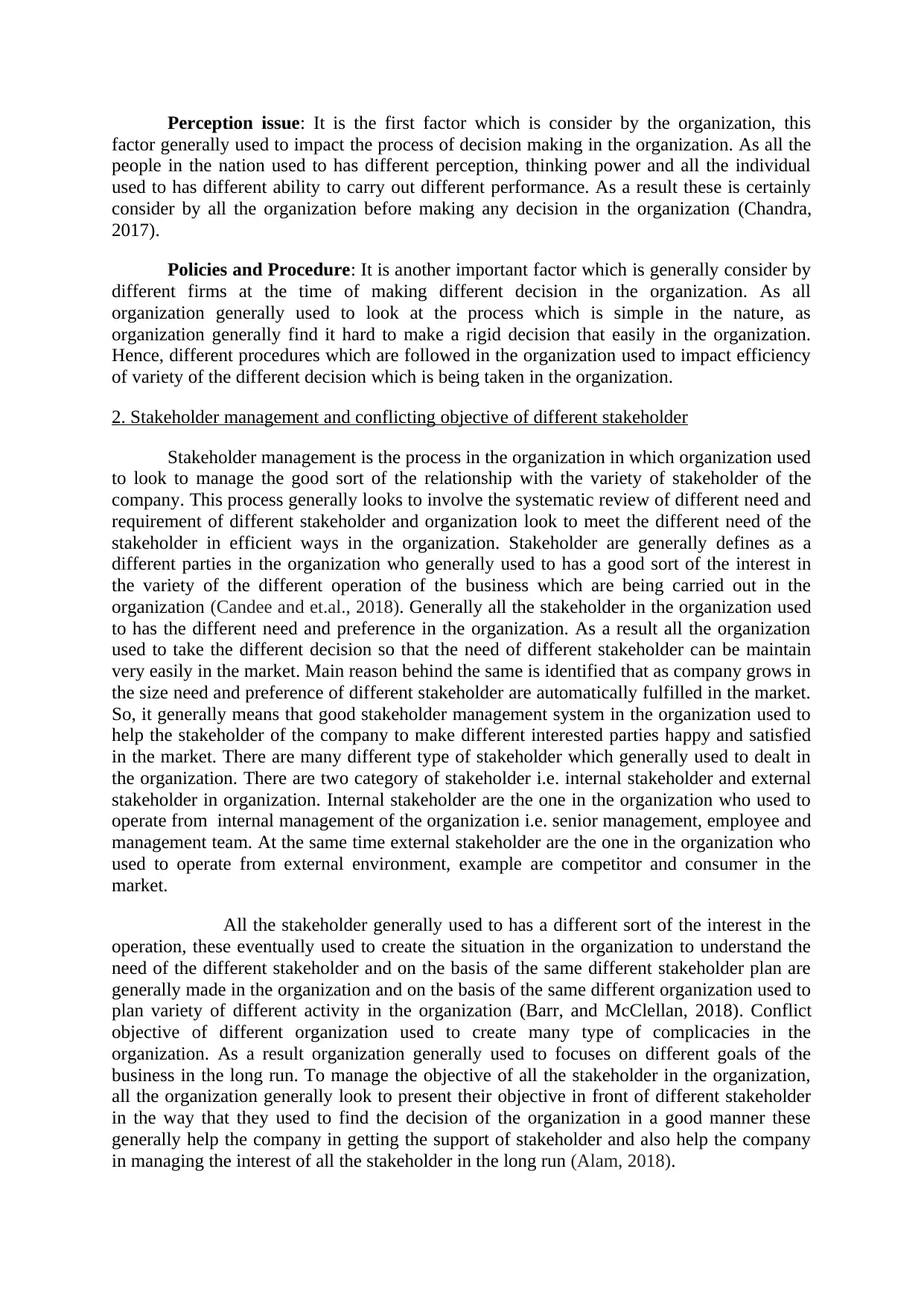
Perception issue: It is the first factor which is consider by the organization, this
factor generally used to impact the process of decision making in the organization. As all the
people in the nation used to has different perception, thinking power and all the individual
used to has different ability to carry out different performance. As a result these is certainly
consider by all the organization before making any decision in the organization (Chandra,
2017).
Policies and Procedure: It is another important factor which is generally consider by
different firms at the time of making different decision in the organization. As all
organization generally used to look at the process which is simple in the nature, as
organization generally find it hard to make a rigid decision that easily in the organization.
Hence, different procedures which are followed in the organization used to impact efficiency
of variety of the different decision which is being taken in the organization.
2. Stakeholder management and conflicting objective of different stakeholder
Stakeholder management is the process in the organization in which organization used
to look to manage the good sort of the relationship with the variety of stakeholder of the
company. This process generally looks to involve the systematic review of different need and
requirement of different stakeholder and organization look to meet the different need of the
stakeholder in efficient ways in the organization. Stakeholder are generally defines as a
different parties in the organization who generally used to has a good sort of the interest in
the variety of the different operation of the business which are being carried out in the
organization (Candee and et.al., 2018). Generally all the stakeholder in the organization used
to has the different need and preference in the organization. As a result all the organization
used to take the different decision so that the need of different stakeholder can be maintain
very easily in the market. Main reason behind the same is identified that as company grows in
the size need and preference of different stakeholder are automatically fulfilled in the market.
So, it generally means that good stakeholder management system in the organization used to
help the stakeholder of the company to make different interested parties happy and satisfied
in the market. There are many different type of stakeholder which generally used to dealt in
the organization. There are two category of stakeholder i.e. internal stakeholder and external
stakeholder in organization. Internal stakeholder are the one in the organization who used to
operate from internal management of the organization i.e. senior management, employee and
management team. At the same time external stakeholder are the one in the organization who
used to operate from external environment, example are competitor and consumer in the
market.
All the stakeholder generally used to has a different sort of the interest in the
operation, these eventually used to create the situation in the organization to understand the
need of the different stakeholder and on the basis of the same different stakeholder plan are
generally made in the organization and on the basis of the same different organization used to
plan variety of different activity in the organization (Barr, and McClellan, 2018). Conflict
objective of different organization used to create many type of complicacies in the
organization. As a result organization generally used to focuses on different goals of the
business in the long run. To manage the objective of all the stakeholder in the organization,
all the organization generally look to present their objective in front of different stakeholder
in the way that they used to find the decision of the organization in a good manner these
generally help the company in getting the support of stakeholder and also help the company
in managing the interest of all the stakeholder in the long run (Alam, 2018).
factor generally used to impact the process of decision making in the organization. As all the
people in the nation used to has different perception, thinking power and all the individual
used to has different ability to carry out different performance. As a result these is certainly
consider by all the organization before making any decision in the organization (Chandra,
2017).
Policies and Procedure: It is another important factor which is generally consider by
different firms at the time of making different decision in the organization. As all
organization generally used to look at the process which is simple in the nature, as
organization generally find it hard to make a rigid decision that easily in the organization.
Hence, different procedures which are followed in the organization used to impact efficiency
of variety of the different decision which is being taken in the organization.
2. Stakeholder management and conflicting objective of different stakeholder
Stakeholder management is the process in the organization in which organization used
to look to manage the good sort of the relationship with the variety of stakeholder of the
company. This process generally looks to involve the systematic review of different need and
requirement of different stakeholder and organization look to meet the different need of the
stakeholder in efficient ways in the organization. Stakeholder are generally defines as a
different parties in the organization who generally used to has a good sort of the interest in
the variety of the different operation of the business which are being carried out in the
organization (Candee and et.al., 2018). Generally all the stakeholder in the organization used
to has the different need and preference in the organization. As a result all the organization
used to take the different decision so that the need of different stakeholder can be maintain
very easily in the market. Main reason behind the same is identified that as company grows in
the size need and preference of different stakeholder are automatically fulfilled in the market.
So, it generally means that good stakeholder management system in the organization used to
help the stakeholder of the company to make different interested parties happy and satisfied
in the market. There are many different type of stakeholder which generally used to dealt in
the organization. There are two category of stakeholder i.e. internal stakeholder and external
stakeholder in organization. Internal stakeholder are the one in the organization who used to
operate from internal management of the organization i.e. senior management, employee and
management team. At the same time external stakeholder are the one in the organization who
used to operate from external environment, example are competitor and consumer in the
market.
All the stakeholder generally used to has a different sort of the interest in the
operation, these eventually used to create the situation in the organization to understand the
need of the different stakeholder and on the basis of the same different stakeholder plan are
generally made in the organization and on the basis of the same different organization used to
plan variety of different activity in the organization (Barr, and McClellan, 2018). Conflict
objective of different organization used to create many type of complicacies in the
organization. As a result organization generally used to focuses on different goals of the
business in the long run. To manage the objective of all the stakeholder in the organization,
all the organization generally look to present their objective in front of different stakeholder
in the way that they used to find the decision of the organization in a good manner these
generally help the company in getting the support of stakeholder and also help the company
in managing the interest of all the stakeholder in the long run (Alam, 2018).
Paraphrase This Document
Need a fresh take? Get an instant paraphrase of this document with our AI Paraphraser
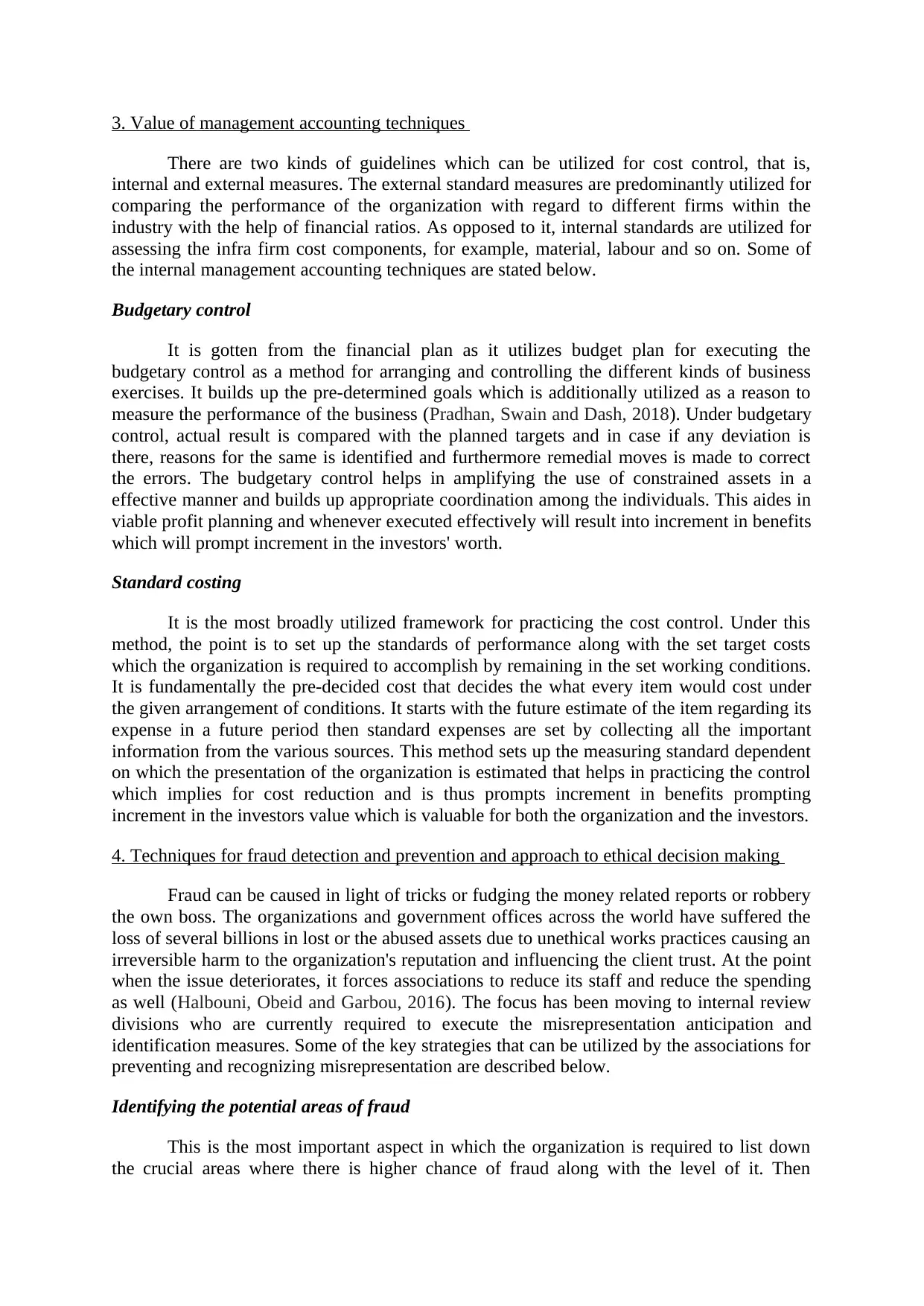
3. Value of management accounting techniques
There are two kinds of guidelines which can be utilized for cost control, that is,
internal and external measures. The external standard measures are predominantly utilized for
comparing the performance of the organization with regard to different firms within the
industry with the help of financial ratios. As opposed to it, internal standards are utilized for
assessing the infra firm cost components, for example, material, labour and so on. Some of
the internal management accounting techniques are stated below.
Budgetary control
It is gotten from the financial plan as it utilizes budget plan for executing the
budgetary control as a method for arranging and controlling the different kinds of business
exercises. It builds up the pre-determined goals which is additionally utilized as a reason to
measure the performance of the business (Pradhan, Swain and Dash, 2018). Under budgetary
control, actual result is compared with the planned targets and in case if any deviation is
there, reasons for the same is identified and furthermore remedial moves is made to correct
the errors. The budgetary control helps in amplifying the use of constrained assets in a
effective manner and builds up appropriate coordination among the individuals. This aides in
viable profit planning and whenever executed effectively will result into increment in benefits
which will prompt increment in the investors' worth.
Standard costing
It is the most broadly utilized framework for practicing the cost control. Under this
method, the point is to set up the standards of performance along with the set target costs
which the organization is required to accomplish by remaining in the set working conditions.
It is fundamentally the pre-decided cost that decides the what every item would cost under
the given arrangement of conditions. It starts with the future estimate of the item regarding its
expense in a future period then standard expenses are set by collecting all the important
information from the various sources. This method sets up the measuring standard dependent
on which the presentation of the organization is estimated that helps in practicing the control
which implies for cost reduction and is thus prompts increment in benefits prompting
increment in the investors value which is valuable for both the organization and the investors.
4. Techniques for fraud detection and prevention and approach to ethical decision making
Fraud can be caused in light of tricks or fudging the money related reports or robbery
the own boss. The organizations and government offices across the world have suffered the
loss of several billions in lost or the abused assets due to unethical works practices causing an
irreversible harm to the organization's reputation and influencing the client trust. At the point
when the issue deteriorates, it forces associations to reduce its staff and reduce the spending
as well (Halbouni, Obeid and Garbou, 2016). The focus has been moving to internal review
divisions who are currently required to execute the misrepresentation anticipation and
identification measures. Some of the key strategies that can be utilized by the associations for
preventing and recognizing misrepresentation are described below.
Identifying the potential areas of fraud
This is the most important aspect in which the organization is required to list down
the crucial areas where there is higher chance of fraud along with the level of it. Then
There are two kinds of guidelines which can be utilized for cost control, that is,
internal and external measures. The external standard measures are predominantly utilized for
comparing the performance of the organization with regard to different firms within the
industry with the help of financial ratios. As opposed to it, internal standards are utilized for
assessing the infra firm cost components, for example, material, labour and so on. Some of
the internal management accounting techniques are stated below.
Budgetary control
It is gotten from the financial plan as it utilizes budget plan for executing the
budgetary control as a method for arranging and controlling the different kinds of business
exercises. It builds up the pre-determined goals which is additionally utilized as a reason to
measure the performance of the business (Pradhan, Swain and Dash, 2018). Under budgetary
control, actual result is compared with the planned targets and in case if any deviation is
there, reasons for the same is identified and furthermore remedial moves is made to correct
the errors. The budgetary control helps in amplifying the use of constrained assets in a
effective manner and builds up appropriate coordination among the individuals. This aides in
viable profit planning and whenever executed effectively will result into increment in benefits
which will prompt increment in the investors' worth.
Standard costing
It is the most broadly utilized framework for practicing the cost control. Under this
method, the point is to set up the standards of performance along with the set target costs
which the organization is required to accomplish by remaining in the set working conditions.
It is fundamentally the pre-decided cost that decides the what every item would cost under
the given arrangement of conditions. It starts with the future estimate of the item regarding its
expense in a future period then standard expenses are set by collecting all the important
information from the various sources. This method sets up the measuring standard dependent
on which the presentation of the organization is estimated that helps in practicing the control
which implies for cost reduction and is thus prompts increment in benefits prompting
increment in the investors value which is valuable for both the organization and the investors.
4. Techniques for fraud detection and prevention and approach to ethical decision making
Fraud can be caused in light of tricks or fudging the money related reports or robbery
the own boss. The organizations and government offices across the world have suffered the
loss of several billions in lost or the abused assets due to unethical works practices causing an
irreversible harm to the organization's reputation and influencing the client trust. At the point
when the issue deteriorates, it forces associations to reduce its staff and reduce the spending
as well (Halbouni, Obeid and Garbou, 2016). The focus has been moving to internal review
divisions who are currently required to execute the misrepresentation anticipation and
identification measures. Some of the key strategies that can be utilized by the associations for
preventing and recognizing misrepresentation are described below.
Identifying the potential areas of fraud
This is the most important aspect in which the organization is required to list down
the crucial areas where there is higher chance of fraud along with the level of it. Then
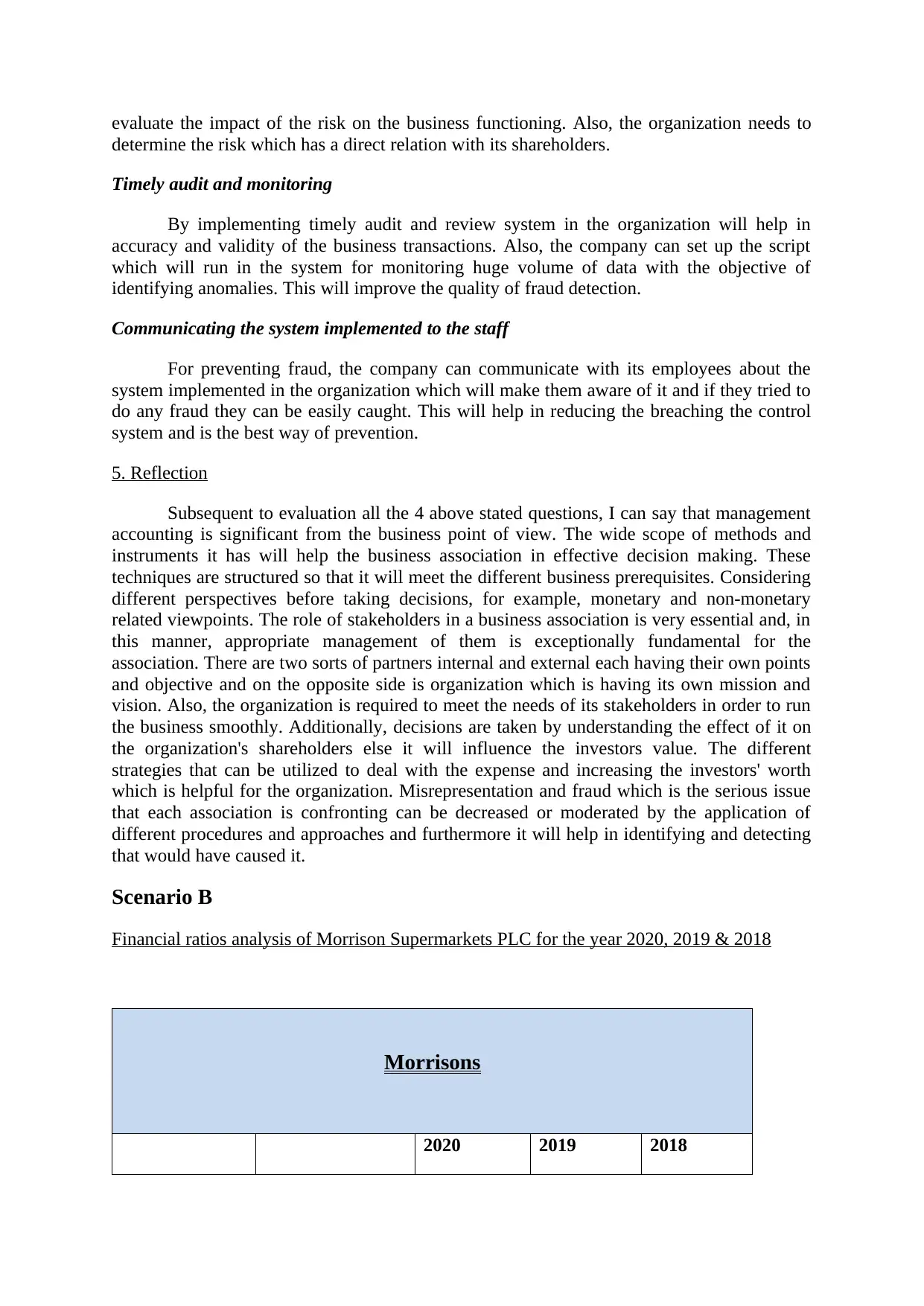
evaluate the impact of the risk on the business functioning. Also, the organization needs to
determine the risk which has a direct relation with its shareholders.
Timely audit and monitoring
By implementing timely audit and review system in the organization will help in
accuracy and validity of the business transactions. Also, the company can set up the script
which will run in the system for monitoring huge volume of data with the objective of
identifying anomalies. This will improve the quality of fraud detection.
Communicating the system implemented to the staff
For preventing fraud, the company can communicate with its employees about the
system implemented in the organization which will make them aware of it and if they tried to
do any fraud they can be easily caught. This will help in reducing the breaching the control
system and is the best way of prevention.
5. Reflection
Subsequent to evaluation all the 4 above stated questions, I can say that management
accounting is significant from the business point of view. The wide scope of methods and
instruments it has will help the business association in effective decision making. These
techniques are structured so that it will meet the different business prerequisites. Considering
different perspectives before taking decisions, for example, monetary and non-monetary
related viewpoints. The role of stakeholders in a business association is very essential and, in
this manner, appropriate management of them is exceptionally fundamental for the
association. There are two sorts of partners internal and external each having their own points
and objective and on the opposite side is organization which is having its own mission and
vision. Also, the organization is required to meet the needs of its stakeholders in order to run
the business smoothly. Additionally, decisions are taken by understanding the effect of it on
the organization's shareholders else it will influence the investors value. The different
strategies that can be utilized to deal with the expense and increasing the investors' worth
which is helpful for the organization. Misrepresentation and fraud which is the serious issue
that each association is confronting can be decreased or moderated by the application of
different procedures and approaches and furthermore it will help in identifying and detecting
that would have caused it.
Scenario B
Financial ratios analysis of Morrison Supermarkets PLC for the year 2020, 2019 & 2018
Morrisons
2020 2019 2018
determine the risk which has a direct relation with its shareholders.
Timely audit and monitoring
By implementing timely audit and review system in the organization will help in
accuracy and validity of the business transactions. Also, the company can set up the script
which will run in the system for monitoring huge volume of data with the objective of
identifying anomalies. This will improve the quality of fraud detection.
Communicating the system implemented to the staff
For preventing fraud, the company can communicate with its employees about the
system implemented in the organization which will make them aware of it and if they tried to
do any fraud they can be easily caught. This will help in reducing the breaching the control
system and is the best way of prevention.
5. Reflection
Subsequent to evaluation all the 4 above stated questions, I can say that management
accounting is significant from the business point of view. The wide scope of methods and
instruments it has will help the business association in effective decision making. These
techniques are structured so that it will meet the different business prerequisites. Considering
different perspectives before taking decisions, for example, monetary and non-monetary
related viewpoints. The role of stakeholders in a business association is very essential and, in
this manner, appropriate management of them is exceptionally fundamental for the
association. There are two sorts of partners internal and external each having their own points
and objective and on the opposite side is organization which is having its own mission and
vision. Also, the organization is required to meet the needs of its stakeholders in order to run
the business smoothly. Additionally, decisions are taken by understanding the effect of it on
the organization's shareholders else it will influence the investors value. The different
strategies that can be utilized to deal with the expense and increasing the investors' worth
which is helpful for the organization. Misrepresentation and fraud which is the serious issue
that each association is confronting can be decreased or moderated by the application of
different procedures and approaches and furthermore it will help in identifying and detecting
that would have caused it.
Scenario B
Financial ratios analysis of Morrison Supermarkets PLC for the year 2020, 2019 & 2018
Morrisons
2020 2019 2018
⊘ This is a preview!⊘
Do you want full access?
Subscribe today to unlock all pages.

Trusted by 1+ million students worldwide
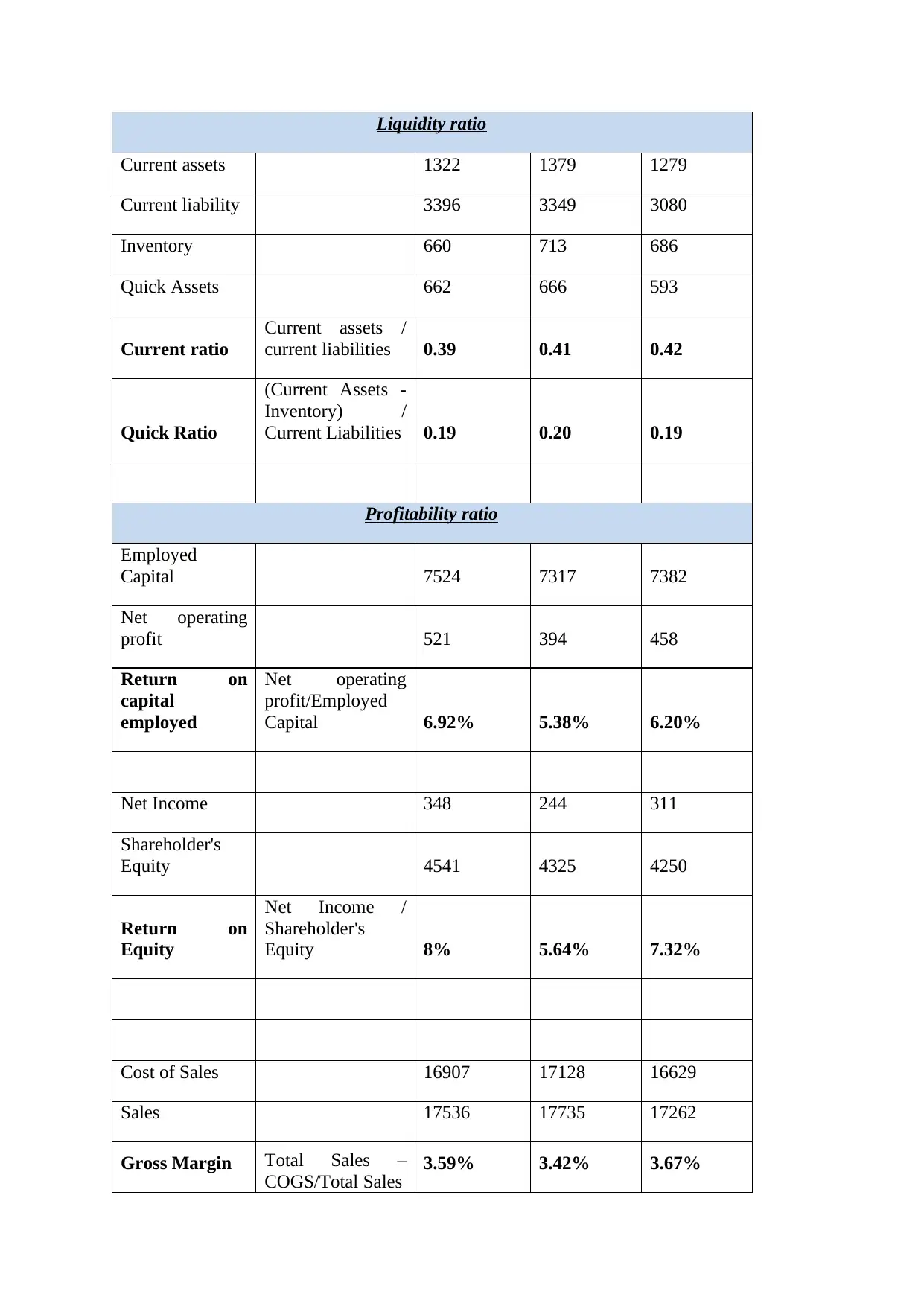
Liquidity ratio
Current assets 1322 1379 1279
Current liability 3396 3349 3080
Inventory 660 713 686
Quick Assets 662 666 593
Current ratio
Current assets /
current liabilities 0.39 0.41 0.42
Quick Ratio
(Current Assets -
Inventory) /
Current Liabilities 0.19 0.20 0.19
Profitability ratio
Employed
Capital 7524 7317 7382
Net operating
profit 521 394 458
Return on
capital
employed
Net operating
profit/Employed
Capital 6.92% 5.38% 6.20%
Net Income 348 244 311
Shareholder's
Equity 4541 4325 4250
Return on
Equity
Net Income /
Shareholder's
Equity 8% 5.64% 7.32%
Cost of Sales 16907 17128 16629
Sales 17536 17735 17262
Gross Margin Total Sales –
COGS/Total Sales 3.59% 3.42% 3.67%
Current assets 1322 1379 1279
Current liability 3396 3349 3080
Inventory 660 713 686
Quick Assets 662 666 593
Current ratio
Current assets /
current liabilities 0.39 0.41 0.42
Quick Ratio
(Current Assets -
Inventory) /
Current Liabilities 0.19 0.20 0.19
Profitability ratio
Employed
Capital 7524 7317 7382
Net operating
profit 521 394 458
Return on
capital
employed
Net operating
profit/Employed
Capital 6.92% 5.38% 6.20%
Net Income 348 244 311
Shareholder's
Equity 4541 4325 4250
Return on
Equity
Net Income /
Shareholder's
Equity 8% 5.64% 7.32%
Cost of Sales 16907 17128 16629
Sales 17536 17735 17262
Gross Margin Total Sales –
COGS/Total Sales 3.59% 3.42% 3.67%
Paraphrase This Document
Need a fresh take? Get an instant paraphrase of this document with our AI Paraphraser

Operating profit 521 394 458
Sales 17536 17735 17262
Net profit ratio
Operating Income/
Net Sales 3.0% 2.22% 2.65%
Efficiency Ratios
Inventory 660 713 686
Trade
Receivables 353 347 250
Net Assets 4541 4325 4250
Cost of Sales 16907 17128 16629
Sales 17536 17735 17262
Asset turnover
ratio Sales / Net assets 3.86 4.10 4.06
Inventory
turnover ratio Sales / Inventory 26.57 24.02 24.24
Account
receivable
turnover ratio
Sales / Accounts
Receivable 49.68 51.11 69.05
Debt
Debt 6379 5285 5122
Equity 4541 4325 4250
Debt equity
ratio Debt/ Equity 1.40 1.22 1.21
Sales 17536 17735 17262
Net profit ratio
Operating Income/
Net Sales 3.0% 2.22% 2.65%
Efficiency Ratios
Inventory 660 713 686
Trade
Receivables 353 347 250
Net Assets 4541 4325 4250
Cost of Sales 16907 17128 16629
Sales 17536 17735 17262
Asset turnover
ratio Sales / Net assets 3.86 4.10 4.06
Inventory
turnover ratio Sales / Inventory 26.57 24.02 24.24
Account
receivable
turnover ratio
Sales / Accounts
Receivable 49.68 51.11 69.05
Debt
Debt 6379 5285 5122
Equity 4541 4325 4250
Debt equity
ratio Debt/ Equity 1.40 1.22 1.21
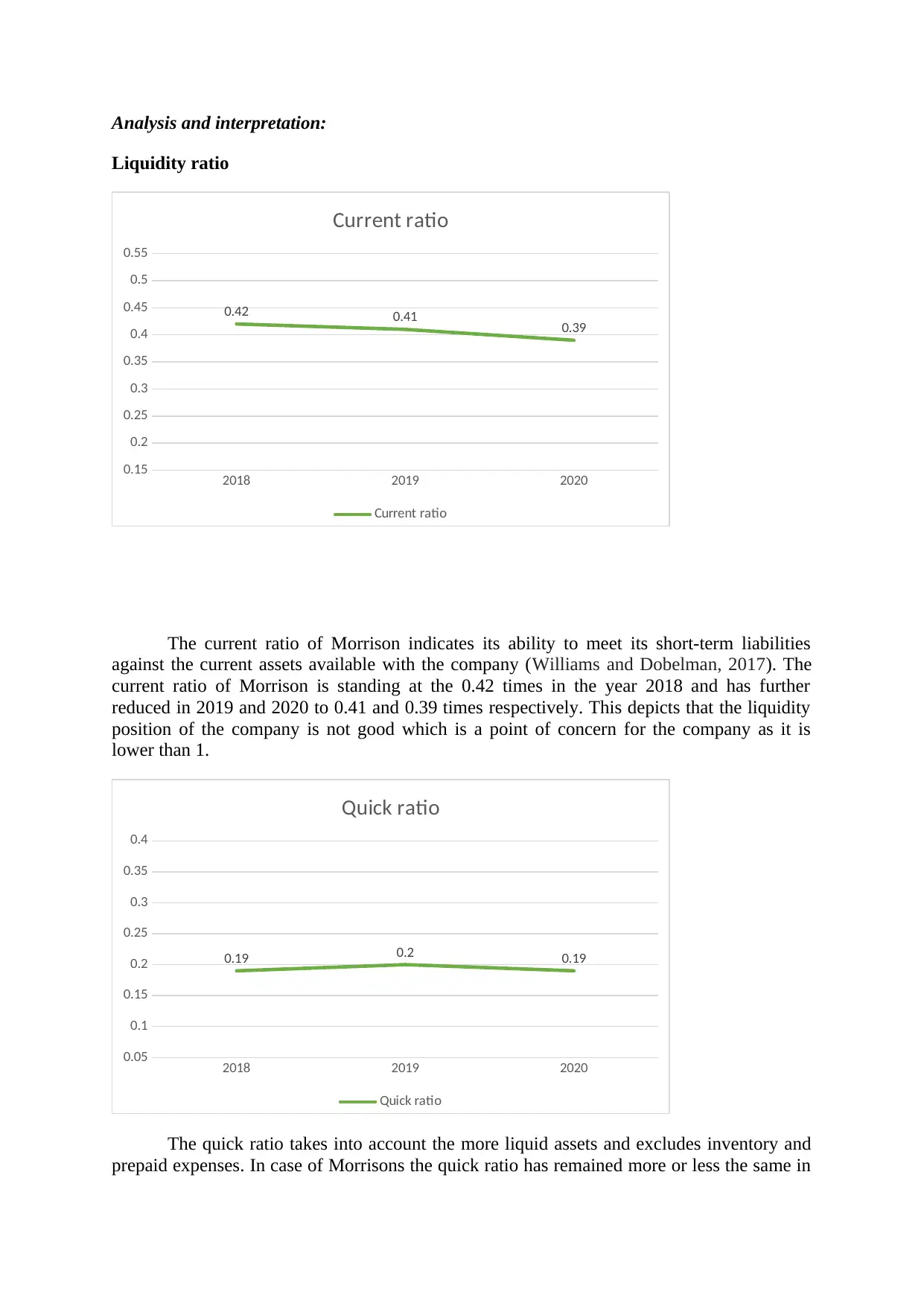
Analysis and interpretation:
Liquidity ratio
The current ratio of Morrison indicates its ability to meet its short-term liabilities
against the current assets available with the company (Williams and Dobelman, 2017). The
current ratio of Morrison is standing at the 0.42 times in the year 2018 and has further
reduced in 2019 and 2020 to 0.41 and 0.39 times respectively. This depicts that the liquidity
position of the company is not good which is a point of concern for the company as it is
lower than 1.
2018 2019 2020
0.05
0.1
0.15
0.2
0.25
0.3
0.35
0.4
0.19 0.2 0.19
Quick ratio
Quick ratio
The quick ratio takes into account the more liquid assets and excludes inventory and
prepaid expenses. In case of Morrisons the quick ratio has remained more or less the same in
2018 2019 2020
0.15
0.2
0.25
0.3
0.35
0.4
0.45
0.5
0.55
0.42 0.41 0.39
Current ratio
Current ratio
Liquidity ratio
The current ratio of Morrison indicates its ability to meet its short-term liabilities
against the current assets available with the company (Williams and Dobelman, 2017). The
current ratio of Morrison is standing at the 0.42 times in the year 2018 and has further
reduced in 2019 and 2020 to 0.41 and 0.39 times respectively. This depicts that the liquidity
position of the company is not good which is a point of concern for the company as it is
lower than 1.
2018 2019 2020
0.05
0.1
0.15
0.2
0.25
0.3
0.35
0.4
0.19 0.2 0.19
Quick ratio
Quick ratio
The quick ratio takes into account the more liquid assets and excludes inventory and
prepaid expenses. In case of Morrisons the quick ratio has remained more or less the same in
2018 2019 2020
0.15
0.2
0.25
0.3
0.35
0.4
0.45
0.5
0.55
0.42 0.41 0.39
Current ratio
Current ratio
⊘ This is a preview!⊘
Do you want full access?
Subscribe today to unlock all pages.

Trusted by 1+ million students worldwide
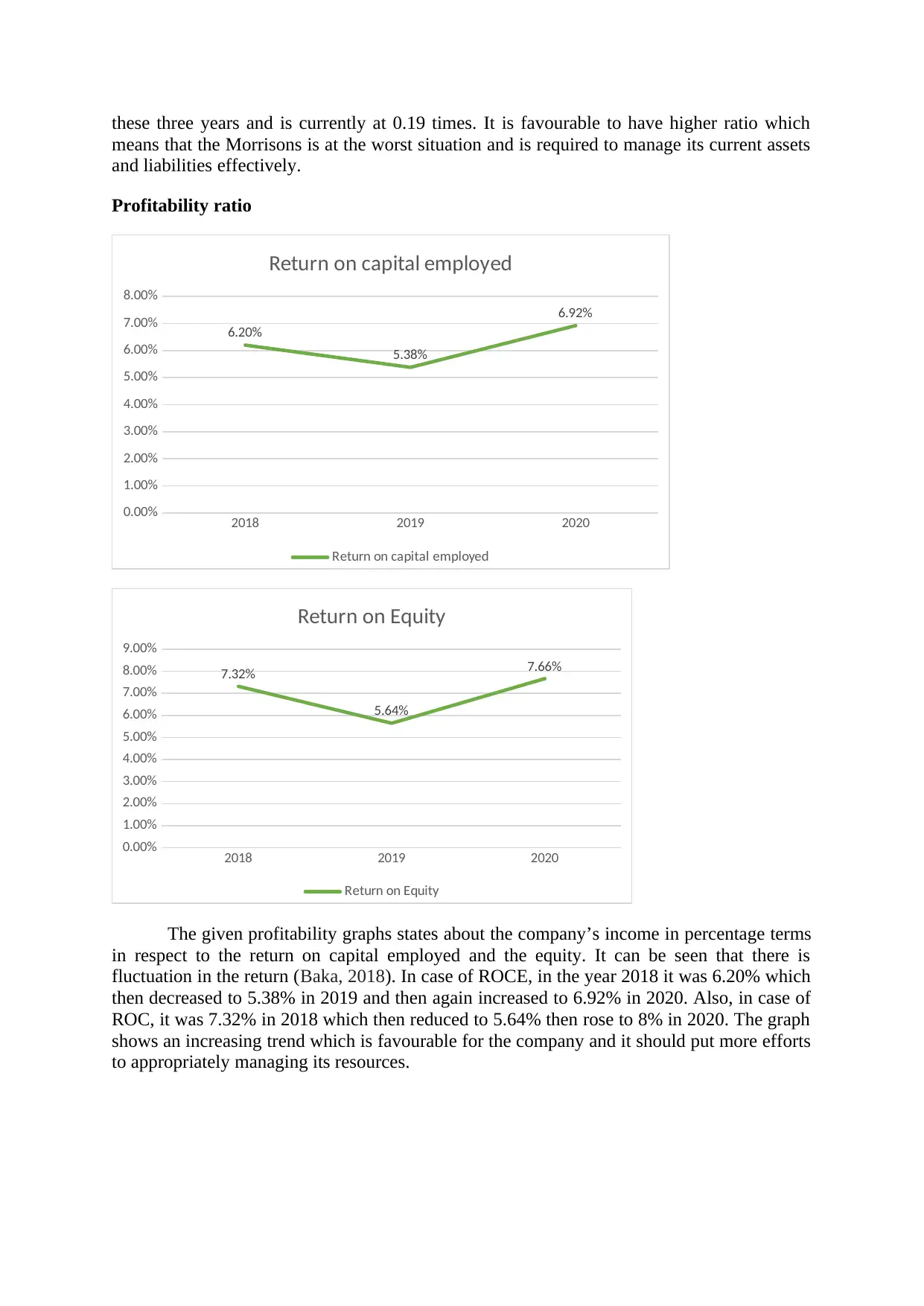
these three years and is currently at 0.19 times. It is favourable to have higher ratio which
means that the Morrisons is at the worst situation and is required to manage its current assets
and liabilities effectively.
Profitability ratio
2018 2019 2020
0.00%
1.00%
2.00%
3.00%
4.00%
5.00%
6.00%
7.00%
8.00%
6.20%
5.38%
6.92%
Return on capital employed
Return on capital employed
2018 2019 2020
0.00%
1.00%
2.00%
3.00%
4.00%
5.00%
6.00%
7.00%
8.00%
9.00%
7.32%
5.64%
7.66%
Return on Equity
Return on Equity
The given profitability graphs states about the company’s income in percentage terms
in respect to the return on capital employed and the equity. It can be seen that there is
fluctuation in the return (Baka, 2018). In case of ROCE, in the year 2018 it was 6.20% which
then decreased to 5.38% in 2019 and then again increased to 6.92% in 2020. Also, in case of
ROC, it was 7.32% in 2018 which then reduced to 5.64% then rose to 8% in 2020. The graph
shows an increasing trend which is favourable for the company and it should put more efforts
to appropriately managing its resources.
means that the Morrisons is at the worst situation and is required to manage its current assets
and liabilities effectively.
Profitability ratio
2018 2019 2020
0.00%
1.00%
2.00%
3.00%
4.00%
5.00%
6.00%
7.00%
8.00%
6.20%
5.38%
6.92%
Return on capital employed
Return on capital employed
2018 2019 2020
0.00%
1.00%
2.00%
3.00%
4.00%
5.00%
6.00%
7.00%
8.00%
9.00%
7.32%
5.64%
7.66%
Return on Equity
Return on Equity
The given profitability graphs states about the company’s income in percentage terms
in respect to the return on capital employed and the equity. It can be seen that there is
fluctuation in the return (Baka, 2018). In case of ROCE, in the year 2018 it was 6.20% which
then decreased to 5.38% in 2019 and then again increased to 6.92% in 2020. Also, in case of
ROC, it was 7.32% in 2018 which then reduced to 5.64% then rose to 8% in 2020. The graph
shows an increasing trend which is favourable for the company and it should put more efforts
to appropriately managing its resources.
Paraphrase This Document
Need a fresh take? Get an instant paraphrase of this document with our AI Paraphraser
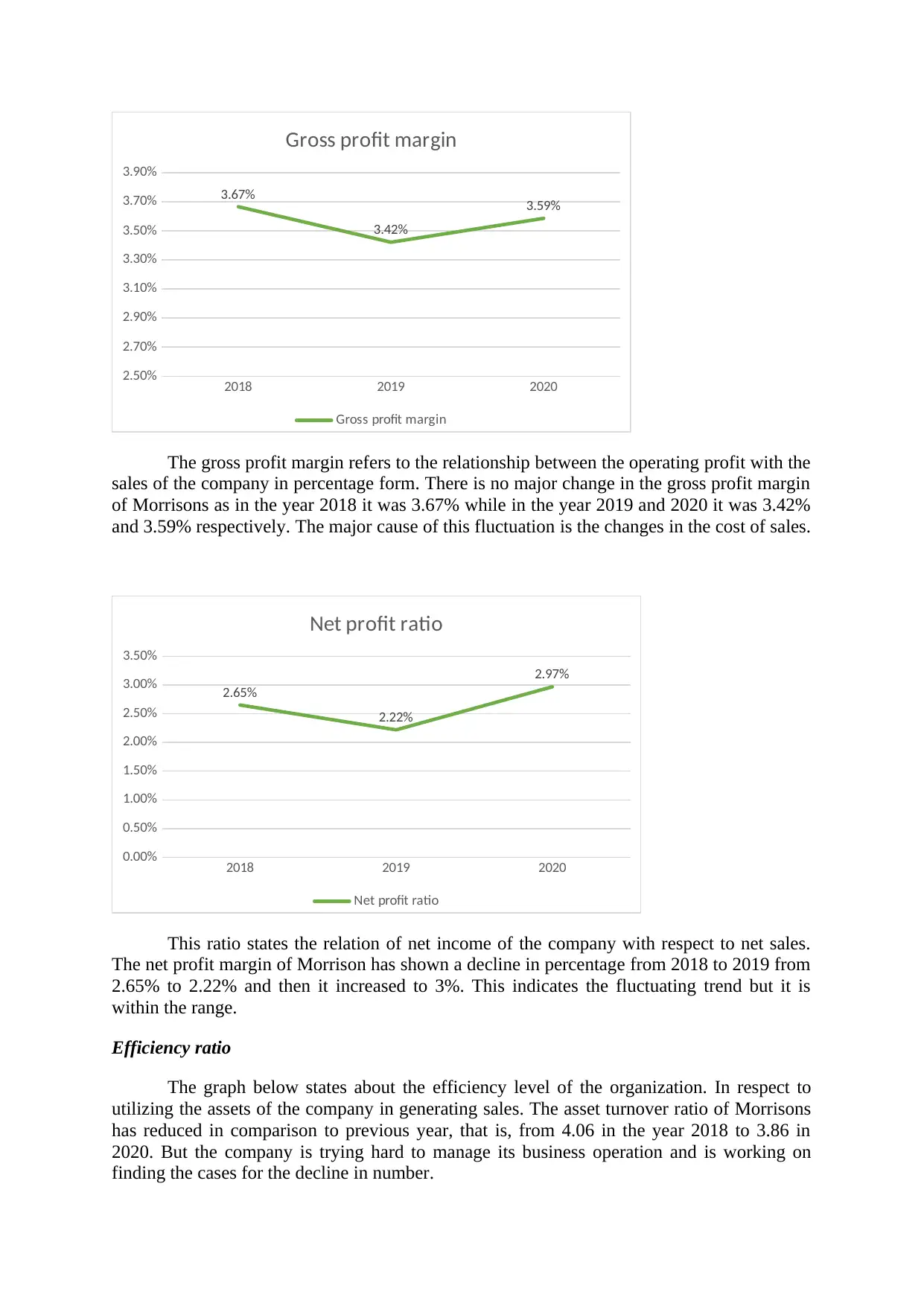
2018 2019 2020
2.50%
2.70%
2.90%
3.10%
3.30%
3.50%
3.70%
3.90%
3.67%
3.42%
3.59%
Gross profit margin
Gross profit margin
The gross profit margin refers to the relationship between the operating profit with the
sales of the company in percentage form. There is no major change in the gross profit margin
of Morrisons as in the year 2018 it was 3.67% while in the year 2019 and 2020 it was 3.42%
and 3.59% respectively. The major cause of this fluctuation is the changes in the cost of sales.
2018 2019 2020
0.00%
0.50%
1.00%
1.50%
2.00%
2.50%
3.00%
3.50%
2.65%
2.22%
2.97%
Net profit ratio
Net profit ratio
This ratio states the relation of net income of the company with respect to net sales.
The net profit margin of Morrison has shown a decline in percentage from 2018 to 2019 from
2.65% to 2.22% and then it increased to 3%. This indicates the fluctuating trend but it is
within the range.
Efficiency ratio
The graph below states about the efficiency level of the organization. In respect to
utilizing the assets of the company in generating sales. The asset turnover ratio of Morrisons
has reduced in comparison to previous year, that is, from 4.06 in the year 2018 to 3.86 in
2020. But the company is trying hard to manage its business operation and is working on
finding the cases for the decline in number.
2.50%
2.70%
2.90%
3.10%
3.30%
3.50%
3.70%
3.90%
3.67%
3.42%
3.59%
Gross profit margin
Gross profit margin
The gross profit margin refers to the relationship between the operating profit with the
sales of the company in percentage form. There is no major change in the gross profit margin
of Morrisons as in the year 2018 it was 3.67% while in the year 2019 and 2020 it was 3.42%
and 3.59% respectively. The major cause of this fluctuation is the changes in the cost of sales.
2018 2019 2020
0.00%
0.50%
1.00%
1.50%
2.00%
2.50%
3.00%
3.50%
2.65%
2.22%
2.97%
Net profit ratio
Net profit ratio
This ratio states the relation of net income of the company with respect to net sales.
The net profit margin of Morrison has shown a decline in percentage from 2018 to 2019 from
2.65% to 2.22% and then it increased to 3%. This indicates the fluctuating trend but it is
within the range.
Efficiency ratio
The graph below states about the efficiency level of the organization. In respect to
utilizing the assets of the company in generating sales. The asset turnover ratio of Morrisons
has reduced in comparison to previous year, that is, from 4.06 in the year 2018 to 3.86 in
2020. But the company is trying hard to manage its business operation and is working on
finding the cases for the decline in number.
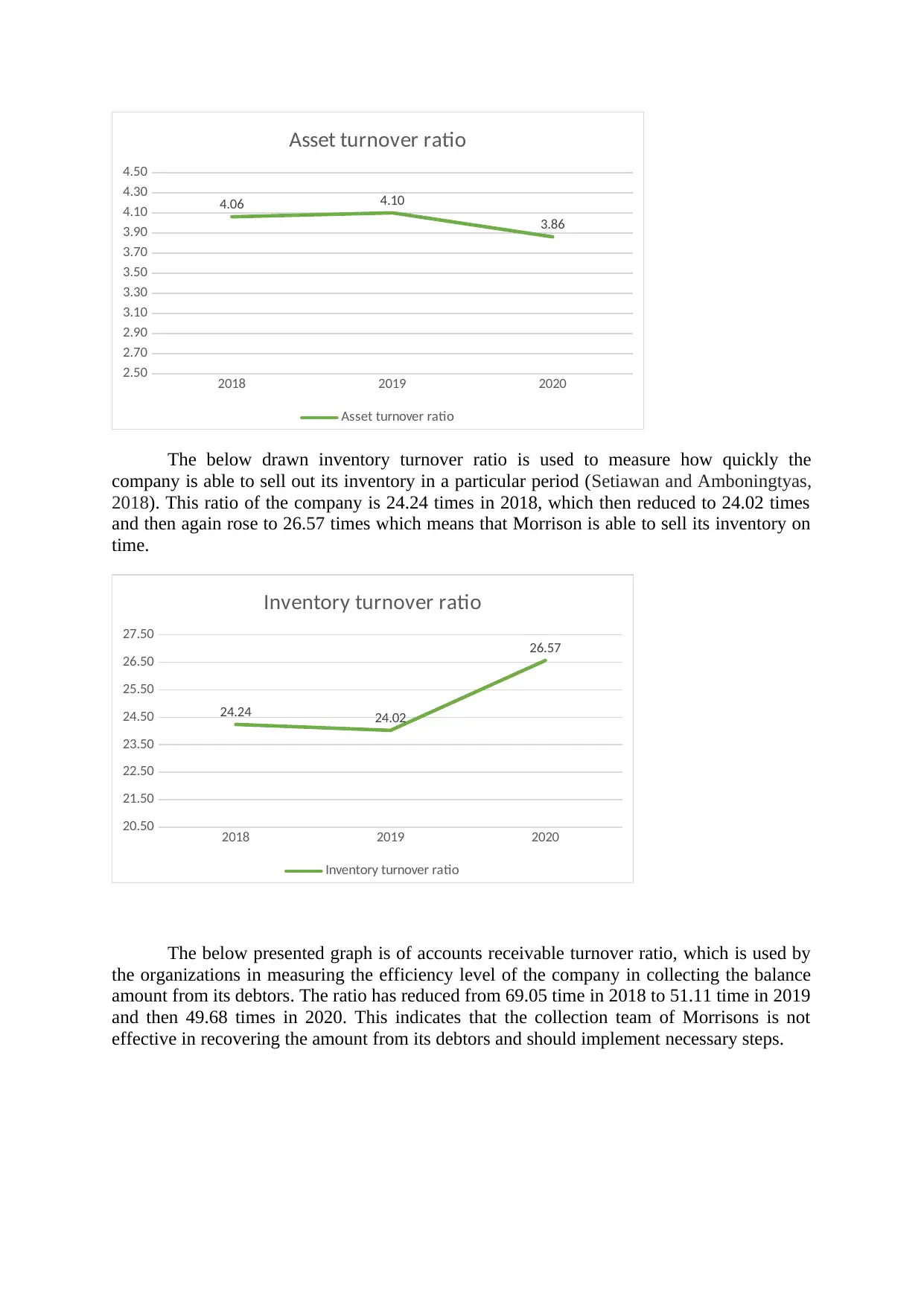
2018 2019 2020
2.50
2.70
2.90
3.10
3.30
3.50
3.70
3.90
4.10
4.30
4.50
4.06 4.10
3.86
Asset turnover ratio
Asset turnover ratio
The below drawn inventory turnover ratio is used to measure how quickly the
company is able to sell out its inventory in a particular period (Setiawan and Amboningtyas,
2018). This ratio of the company is 24.24 times in 2018, which then reduced to 24.02 times
and then again rose to 26.57 times which means that Morrison is able to sell its inventory on
time.
2018 2019 2020
20.50
21.50
22.50
23.50
24.50
25.50
26.50
27.50
24.24 24.02
26.57
Inventory turnover ratio
Inventory turnover ratio
The below presented graph is of accounts receivable turnover ratio, which is used by
the organizations in measuring the efficiency level of the company in collecting the balance
amount from its debtors. The ratio has reduced from 69.05 time in 2018 to 51.11 time in 2019
and then 49.68 times in 2020. This indicates that the collection team of Morrisons is not
effective in recovering the amount from its debtors and should implement necessary steps.
2.50
2.70
2.90
3.10
3.30
3.50
3.70
3.90
4.10
4.30
4.50
4.06 4.10
3.86
Asset turnover ratio
Asset turnover ratio
The below drawn inventory turnover ratio is used to measure how quickly the
company is able to sell out its inventory in a particular period (Setiawan and Amboningtyas,
2018). This ratio of the company is 24.24 times in 2018, which then reduced to 24.02 times
and then again rose to 26.57 times which means that Morrison is able to sell its inventory on
time.
2018 2019 2020
20.50
21.50
22.50
23.50
24.50
25.50
26.50
27.50
24.24 24.02
26.57
Inventory turnover ratio
Inventory turnover ratio
The below presented graph is of accounts receivable turnover ratio, which is used by
the organizations in measuring the efficiency level of the company in collecting the balance
amount from its debtors. The ratio has reduced from 69.05 time in 2018 to 51.11 time in 2019
and then 49.68 times in 2020. This indicates that the collection team of Morrisons is not
effective in recovering the amount from its debtors and should implement necessary steps.
⊘ This is a preview!⊘
Do you want full access?
Subscribe today to unlock all pages.

Trusted by 1+ million students worldwide
1 out of 17
Related Documents
Your All-in-One AI-Powered Toolkit for Academic Success.
+13062052269
info@desklib.com
Available 24*7 on WhatsApp / Email
![[object Object]](/_next/static/media/star-bottom.7253800d.svg)
Unlock your academic potential
Copyright © 2020–2025 A2Z Services. All Rights Reserved. Developed and managed by ZUCOL.





